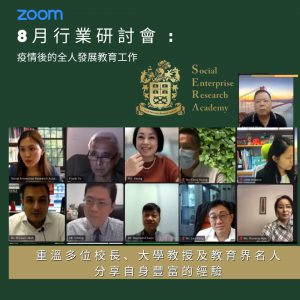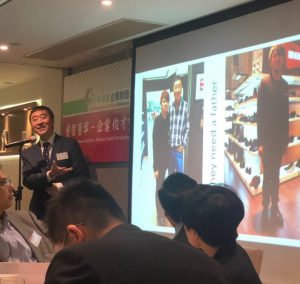In most of the large-scaled industries, to promote, job-hop or to get a higher pay requires skills and abilities of employees. If the qualities of the job seekers are similar, their educational qualifications would be the decisive factor. However, for the job seekers who have entered the society at a young age, the educational qualification would be their shortcoming for job searching. On-job training sounds easy, it is actually the opposite to the job-seeker. We have interviewed two young people with on-job training, their experience would definitely allow readers to have a deeper understanding towards the issue.
According to JobsDB’s “Hiring, Compensation & Benefits Survey Report” published at the end of last year, whether the employers employ the job seeker, the employer considers three factors: “related work experience” (68%), “educational qualification” (51%) and “Expected salary profit” (51%).

Calvin is 30 years old this year. After graduating from the secondary five, he enrolled in the three-year Advanced Diploma in Testing and Certification by Hong Kong Institute of Vocational Education (IVE). He has worked in Foxconn, WKK Distribution Ltd. and a well-known semiconductor company in Japan and he was responsible for quality management.
For on-job training, Calvin felt that the employer valued the strength of employees and the educational qualifications did not reflect their ability. Therefore, for the first two to three years after graduated from IVE, he did not consider further training. “In the past, I was younger and I often felt that educational qualification is not a thing. I even disdained at the saying of “certificate is the entrance ticket”,” Calvin recalls.
Later, the company hired an inexperienced university graduate, and his position was the same as Calvin, and he felt bad at this. “I am more experienced than him, and I can handle a lot of problems, but I seem to see my ceiling at that moment,” Calvin said. After he calmed down and thought, he had to level up to the next level. He needed a degree, at least a bachelor’s degree. At the same time, he also hopes that he will equip himself to meet the challenges in the future.
In the end, Calvin invested more than 100,000 in 2013 and enrolled in the Bachelor of Science in Product Analysis and Engineering Design at the Hong Kong Polytechnic University. He began taking the 4 year part-time degree and working at the same time.
The “2016 Population By-census Main Results” published by the Census and Statistics Department, shows that among the 3.333 million employees in Hong Kong, a total of 1.052 million people work 50 hours or more per week. It accounts for 31.6% of all employees in Hong Kong.
“In general, we have to take two to three courses in a semester. We must be taking the courses at night and a class lasts for three hours. While on weekdays, I go to work from eight to five, sometimes I need to work overtime. It is hard for me to maintain a work-study balance, not mentioning about work-life balance” Calvin said. At that time, he had to cope with his homework and group project, adding on his work. He lived a very busy life and he had a serious lack of sleep. He said lucikly he finished the degree of Bachelor of Science.
Another working learners Rick is thirty two this year, and he is a salesperson at the fitness company. He entered the workplace at the age of 16 and has nearly 20 years of work experience. He began his part-time Bachelor of Business Administration degree at the Open University in 2015.
Compared with Calvin, Rick’s working hours are from ten to ten, and 7pm is the busiest working hour. However, school starts at this time. It is necessary to arrange the time for work and class to make time for further study. As a result, Rick can only take one or two courses per semester, and it takes longer time to get enough credits for graduation.
“For workers with further studies, the flexibility of the course is particularly important,” Rick continued, as not all employees have their working hours fixed at “9 to 5”. One of the reasons why he chose this course is that there is no requirements for students to take multiple courses, they can only take one course with three credits in one semester.
After being asked about the future path after getting a degree, Rick unexpectedly said, “To be honest, education has no effect on the career path of Sales. Some students studies because they want a promotion, and I simply want to learn more during the process of studying. I would like to apply my knowledge in reality, or to have the opportunity to make investments and do business.”
However, Rick admits that with the educational qualification, the opportunity for promotion is indeed more, but when it comes to further training, money is actually a very important consideration. He points out that “if the Continuing Education Fund can have a greater funding, and to give those who have lower income a greater fund, it would be much better.”
Even if everyone understands that continuing education can directly improve labor competitiveness, the continuing education population has been declining year after year. The Government responded to this question at the beginning of last year that external factors such as the trend of the labour market and the courses offered by training institutions affect the number of applications for the Hong Kong Continuing Education Fund. Some personal factors, including the length of working hours and the interest in further studies, have also slowed down the number of applications for the Continuing Education Fund.

The number of applications for the Continuing Education Fund fell from 73,000 in 2006 to less than 20,000 in 2016. This is more or less a reflection of two things. One is that the public’s desire for further studies is declining. The second is that the courses enrolled by the employees are not covered by the Continuing Education Fund.
To maintain Hong Kong’s competitiveness, it is a must to encourage the public to learn and help the employees. In overseas, there are ways of using study leave to encourage employees to pursue further education. For example, the Austrian city Weiterbildungsgeld allows employees to reach an agreement with their employer for 365 days of unpaid leave, while employees receive a benefit equivalent to unemployment benefits.
Singapore introduces the Workfare Training Support Scheme, where local employers can apply to the government for absence pay subsidies of 95% of their employees’ basic hourly wages. The plan is mainly for employees aged 35 or more with monthly income of no more than SGD 2,000 (about HKD 11,500).
In addition to the Fund and other subsidy schemes, the Government has a policy to allow employers to have their profit tax deducting the expense of training the employees. However, this is far from enough. The Government can also refer to the above-mentioned methods of the relevant countries to enhance the employees’ satisfaction in learning, while balancing the employment relationship so that employers can retain and recruit talents. It is also necessary to update the funding of the Fund and other funding schemes in a timely manner to benefit the public. It would be a win-win situation in long run.

































